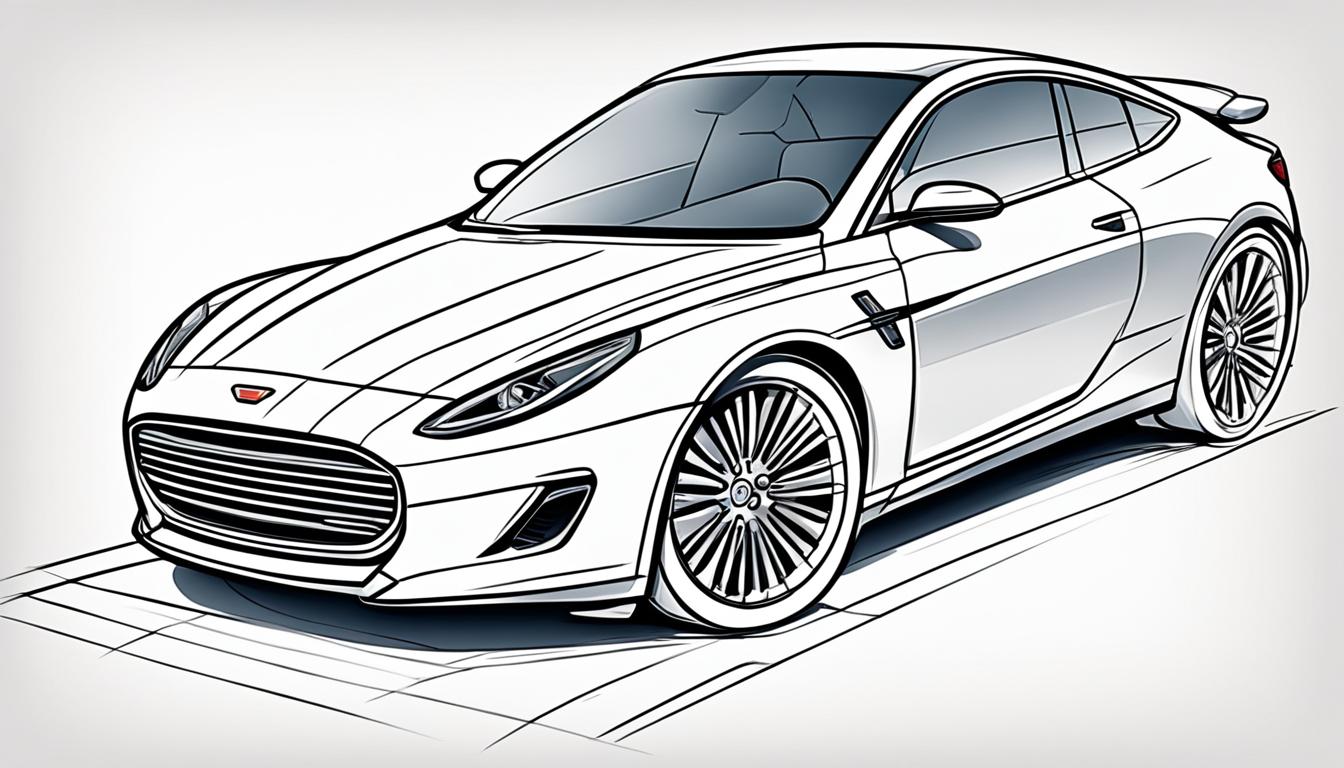How to Draw a Car – Drawing Turorials and Coloring Tips
Have you ever wondered how to bring your favorite cars to life on paper? Whether you’re a budding artist or just looking to explore your creative side, learning to draw a car can be a fun and rewarding experience. But where do you start? How do you capture the sleek curves, the intricate details, and the essence of a car in a piece of art?
In this article, we’ve got you covered with step-by-step tutorials, expert tips, and coloring techniques to help you master the art of car drawing. From realistic car designs to conceptual masterpieces and even cartoon creations, we’ll guide you through the process, empowering you to unlock your artistic potential and create stunning car illustrations.
Whether you’re a beginner or looking to refine your skills, this comprehensive guide will take you on a creative journey, providing the knowledge and inspiration you need to draw cars like a pro. So buckle up and let’s get started!
Key Takeaways:
- Learn step-by-step techniques for drawing realistic cars
- Discover the art of conceptual car design
- Create fun and whimsical cartoon car drawings
- Explore coloring tips and techniques to bring your car drawings to life
- Personalize and customize your car designs to make them unique
Realistic Car Drawing Tutorial
In this section, artist Ben House shares his step-by-step process for creating a realistic car drawing using perspective. By establishing perspective beforehand, you can achieve accurate proportions and bring your car to life on paper.
Step 1: Understand Perspective
Before you begin drawing, it’s essential to grasp the concept of perspective. Perspective helps create the illusion of depth and three-dimensionality in your artwork. Take the time to study the basics of one-point and two-point perspective, as they will guide your car drawing.
Step 2: Sketch the Basic Shapes
Start by sketching the basic shapes of the car using light, loose lines. Focus on capturing the overall proportions and shape division of the vehicle. Remember to reference images or real cars to ensure accuracy.
Step 3: Outline the Body
Once you’re satisfied with the basic shapes, begin outlining the car’s body using more defined lines. Pay attention to the contours and curves that define the vehicle’s unique silhouette.
Step 4: Add Wheel Proportions
Next, add the wheels to your drawing, keeping in mind their accurate proportions and positioning. Wheels play a crucial role in grounding the car and adding realism to your artwork.
Step 5: Refine Details
Now it’s time to refine the details of your car drawing. Focus on adding important features such as headlights, grille, windows, doors, and other distinct elements. This step will bring your car to life and make it recognizable.
Step 6: Shading for Realism
To achieve a realistic look, shading is essential. Use various shading techniques such as hatching, cross-hatching, and blending to create shadows, highlights, and depth in your drawing. Experiment with different tones to add dimension and realism to the car’s body.
By following these steps and paying attention to perspective, proportions, and details, you can create a realistic car drawing that captures the essence and beauty of the vehicle.
Conceptual Car Drawing Tutorial
In this section, designer Jay Shuster presents a step-by-step guide to drawing a conceptual car, as used by car designers and animators. The tutorial focuses on creating a side view of the car, including establishing the ground line, drawing the sill line, adding character lines, sketching the greenhouse and windows, outlining the doors and external features, and shading for dimension. The tutorial encourages a looser, more design-oriented approach, using big shapes and focusing on the overall attitude and energy of the car.
Creating a conceptual car is an exciting opportunity to explore your creativity and showcase your unique design style. Jay Shuster’s tutorial provides a comprehensive breakdown of the drawing process, allowing you to learn key techniques and develop your skills. By following Jay’s step-by-step instructions, you’ll gain a deeper understanding of how to capture the essence and personality of a car in your artwork.
One important aspect of a conceptual car drawing is establishing the ground line. This line serves as the foundation for the car’s perspective and positioning. It helps create a sense of depth and realism in the drawing. By mastering this fundamental technique, you’ll be able to accurately convey the car’s stance and make it appear grounded in its environment.

Once you have the ground line set, you can begin adding the car’s basic shapes, starting with the sill line. This line defines the bottom edge of the car’s body and sets the overall height and proportions. From there, you can add character lines to accentuate the car’s curves and contours, bringing it to life on the page.
Sketching the greenhouse and windows is another crucial step in creating a realistic, yet imaginative, car design. The greenhouse refers to the car’s cabin area, including the windshield, side windows, and rear window. By carefully sketching these elements, you can emphasize the car’s profile and overall shape.
Outlining the doors and external features, such as headlights, grilles, and other details, further enhance the car’s design and give it a distinct personality. The tutorial guides you through this process, ensuring that each element is accurately represented and contributes to the overall visual impact of the drawing.
Finally, shading adds depth and dimension to the conceptual car. By strategically adding shadows and highlights, you can create the illusion of three-dimensionality and make the car appear more realistic. The tutorial provides tips and techniques for shading effectively, capturing the play of light and shadow on the car’s surfaces.
Throughout the tutorial, Jay Shuster emphasizes the importance of a design-oriented approach. Rather than merely replicating a specific car model, you are encouraged to infuse your drawing with creativity and imagination. By using big shapes and focusing on the overall attitude and energy of the car, you can create a unique and visually captivating conceptual design.
So, grab your sketchbook, sharpen your pencils, and get ready to embark on an exciting journey of conceptual car drawing. Follow Jay Shuster’s tutorial and unleash your artistic potential to create stunning and innovative car designs.
Drawing a Cartoon Car Tutorial
Create a fun and playful cartoon car with this step-by-step tutorial. Whether you’re a beginner or looking for some car sketching ideas, this guide will help you bring your imagination to life.

To start, use simple circle shapes for the wheels. Place them evenly apart, keeping in mind the car’s overall proportions. Next, add a rectangular bumper at the front.
Now, it’s time to outline the car’s body. Use curved lines to create a sleek and dynamic shape. Remember, this is a cartoon car, so feel free to exaggerate the curves and make it more playful.
Add windows to the car by drawing two curved lines along the sides. Then, embellish the car with headlights, taillights, and door handles. These small details will bring your cartoon car to life.
When sketching, start with a light pencil to lay down the initial lines. Once you’re happy with the proportions and shapes, trace over them with a pen or a darker pencil for a bolder appearance.
To capture more details and make your drawing pop, consider enlarging the image. This will allow you to add more intricate features and showcase your creativity.
Remember, this is your cartoon car, so don’t be afraid to add some personal touches. You can experiment with different colors, patterns, or even add fun elements like racing stripes or oversized wheels.
With this tutorial, you’ll learn the basics of drawing a cartoon car and gain valuable insights into car drawing for beginners. So grab your pencil and let your imagination hit the road!
Coloring and Adding Details
Once your car drawing is complete, it’s time to bring it to life with color and added details. This section will provide you with valuable tips to enhance your artwork and create a stunning finished piece.
Choose Vibrant Colors
When coloring your car, opt for vibrant colors that will make it stand out. Consider the overall mood or theme of your drawing and select colors that reflect that. Don’t be afraid to experiment and mix different hues to create depth and visual interest.
Referencing Real Cars
To add authenticity and realism to your car drawing, take inspiration from real cars. Reference images of different car models, paying attention to their color schemes, patterns, and details. This will help you capture the essence of a real car in your artwork.
Add Extra Details
To make your car drawing truly unique, consider adding extra details beyond the basic structure. You can include elements like exhaust smoke, decals, or background elements that complement the car. These additional details will make your artwork more dynamic and visually appealing.
Utilize Reference Materials
Using reference materials such as photographs or magazines can greatly assist you in capturing accurate details and proportions. Reference materials allow you to observe how light and shadow interact with the car, helping you achieve a more realistic and visually striking result.
Encourage Creativity
While it’s essential to draw inspiration from real cars, don’t be afraid to let your creativity shine. Add your personal touch by experimenting with unique color combinations, patterns, or even custom designs. This will make your artwork reflect your artistic style and personality.
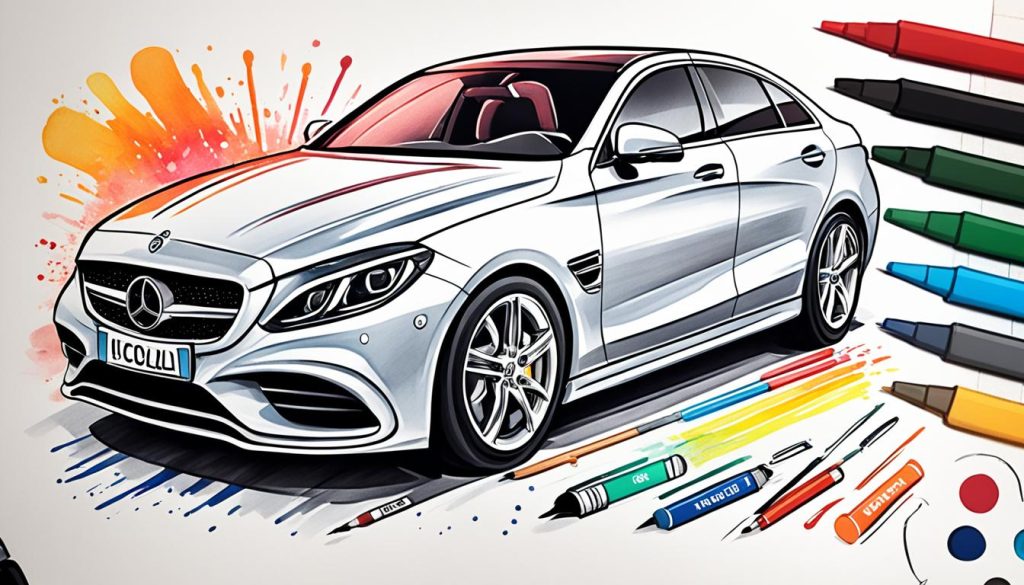
Remember, coloring and adding details to your car drawing is where you can truly make it your own. Let your imagination soar, and let your colors bring life to your masterpiece!
Tips and Tricks for Car Drawing
When it comes to drawing cars, there are always ways to improve your skills and techniques. Whether you’re a beginner or have some experience, these tips and tricks will help you take your car drawings to the next level.
Start with Bigger Paper
If you’re working on a traditional drawing, starting with a bigger paper allows you to add more details and capture the intricacies of the car. It gives you more space to work with and prevents you from feeling cramped as you add finer elements to your drawing.
Use Reference Photos
Referencing photos of cars is crucial for understanding their proportions and details. Study different car models and angles to get a good grasp of how they are structured. Pay close attention to the different shapes, curves, and lines that make up the car’s body. This will help you create more accurate and realistic drawings.
Utilize Layers for Digital Drawing
If you’re using digital tools for your car drawing, take advantage of layers. Layers allow you to make adjustments easily and refine your final lines without affecting the rest of your drawing. Experiment with different layering techniques to achieve the desired effects and make your car drawing stand out.
Practice and Experiment
Like any skill, drawing cars requires practice. Set aside dedicated time to practice drawing cars regularly. Experiment with different styles and techniques to find your own unique approach. Don’t be afraid to make mistakes – they are an essential part of the learning process. Embrace the journey of continuous improvement and exploration.
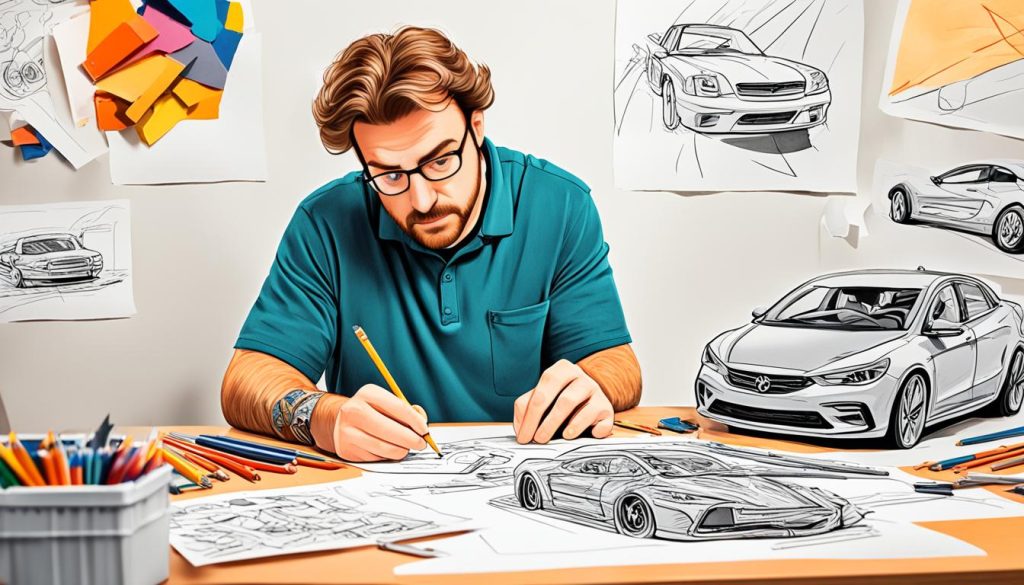
| Tips for Car Drawing | Techniques |
|---|---|
| Start with bigger paper | Allows for more details |
| Use reference photos | Learn proportions and details |
| Utilize layers for digital drawing | Easily make adjustments and refine lines |
| Practice and experiment | Develop your own style |
The Art of Car Design
Car design is an art form that combines technical skill, creativity, and problem-solving. In this section, we delve into the techniques and processes used by professionals to create stunning car designs that captivate our imagination.
The Importance of Sketching and Sketchbooks
Sketching plays a crucial role in the car design process. It allows designers to explore different ideas, iterate on concepts, and refine their vision. Sketchbooks become a treasure trove of inspiration, serving as a repository for ideas, doodles, and observations. Designers often carry sketchbooks with them to capture fleeting thoughts or interesting design cues they come across in their everyday lives.
Perspective, Proportion, and Shape Division
Understanding perspective, proportion, and shape division is essential for creating visually pleasing car designs. Perspective helps convey depth and three-dimensionality, making the car look realistic and dynamic. Proportion ensures that the various elements of the car, such as the body, wheels, and windows, are balanced harmoniously. Shape division allows designers to break down the car into its constituent parts, making it easier to refine the design and add intricate details.
“Car design is about creativity and solving complex design challenges. It’s a delicate balance between aesthetics and functionality, where every line and curve contributes to the overall personality of the vehicle.” – Sarah Johnson, Car Designer
The Mindset and Approach of Car Designers
Car designers approach their work with a blend of technical expertise and artistic flair. They constantly seek inspiration from various sources, including nature, architecture, and contemporary trends. They also keep up with the latest advancements in technology and materials to incorporate innovative features into their designs. Car designers embrace experimentation, pushing boundaries to create groundbreaking concepts that shape the future of automotive design.
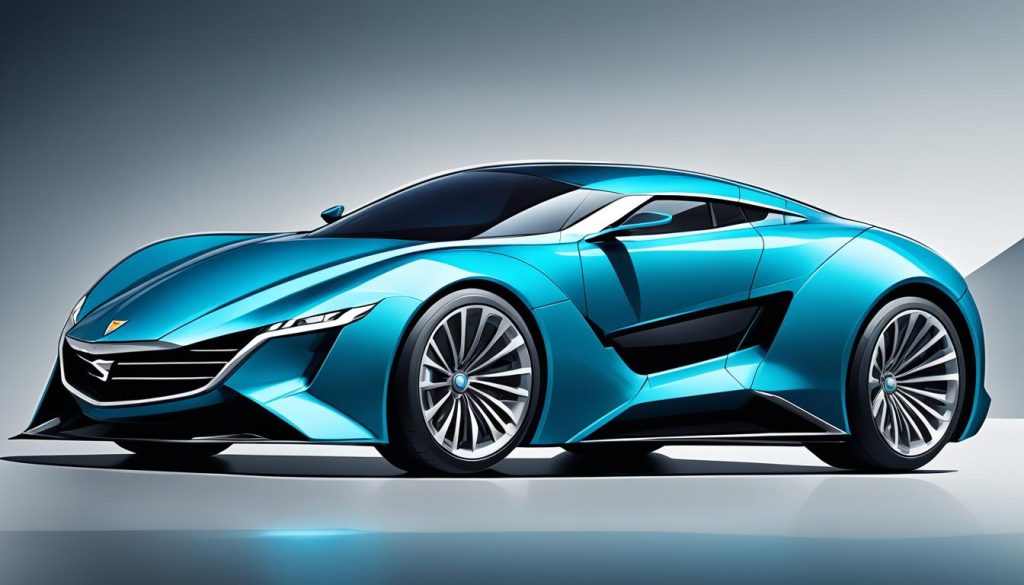
| Car Design Techniques | Car Sketching Ideas | Vehicle Drawing Tutorials | Car Illustration Techniques |
|---|---|---|---|
| Gesture drawing | Exploring futuristic concepts | Drawing different types of vehicles | Mastering shading and highlighting |
| Using different line weights | Incorporating nature-inspired elements | Understanding car proportions | Creating dynamic perspectives |
| Collaborating with sculptors and engineers | Experimenting with unconventional forms | Adding intricate interior details | Utilizing digital tools for rendering |
Car design is a captivating fusion of artistry and engineering. It requires a deep understanding of car anatomy, an appreciation for aesthetics, and a willingness to push creative boundaries. Whether you aspire to become a car designer or simply want to explore this fascinating discipline, learning car drawing techniques, exploring car sketching ideas, and studying vehicle drawing tutorials can deepen your appreciation for the world of car design.
Car Drawing as a Learning Tool for Kids
Introducing kids to car drawing not only taps into their fascination with vehicles but also nurtures their artistic and design skills. Drawing cars can be an exciting way to engage young learners, especially those who have an interest in mechanical or technical subjects. By encouraging them to explore their creativity through car drawing projects, we can develop their imagination and foster a love for art.
One simple and effective way to get kids started with car drawing is through a step-by-step tutorial. Here’s a beginner-friendly approach:
- Begin by drawing a horizontal line across the center of the page. This line will act as the ground, providing a point of reference for the car.
- Next, draw two circles at the bottom of the page, slightly overlapping the ground line. These circles will form the car’s wheels.
- Connect the circles with two straight lines, representing the axles.
- Above the wheels, draw a rectangle for the car’s body.
- Add windows, doors, and other details to bring the car to life.
- Finally, let your imagination rev up by customizing your car’s design and adding any additional details you’d like.
This simple tutorial serves as a starting point for kids to explore their creativity and develop their own unique car drawings. Encourage them to experiment with different car shapes, colors, and designs to make their drawings truly their own.
Through car drawing, children not only learn about shapes, lines, and proportions but also enhance their observation skills and attention to detail. They begin to understand the relationship between different parts of a car and how they work together to create a unified whole.
Furthermore, car drawing offers a platform for self-expression and encourages young artists to think outside the box. It fosters a sense of individuality as they customize and personalize their car designs with their own creative flair.
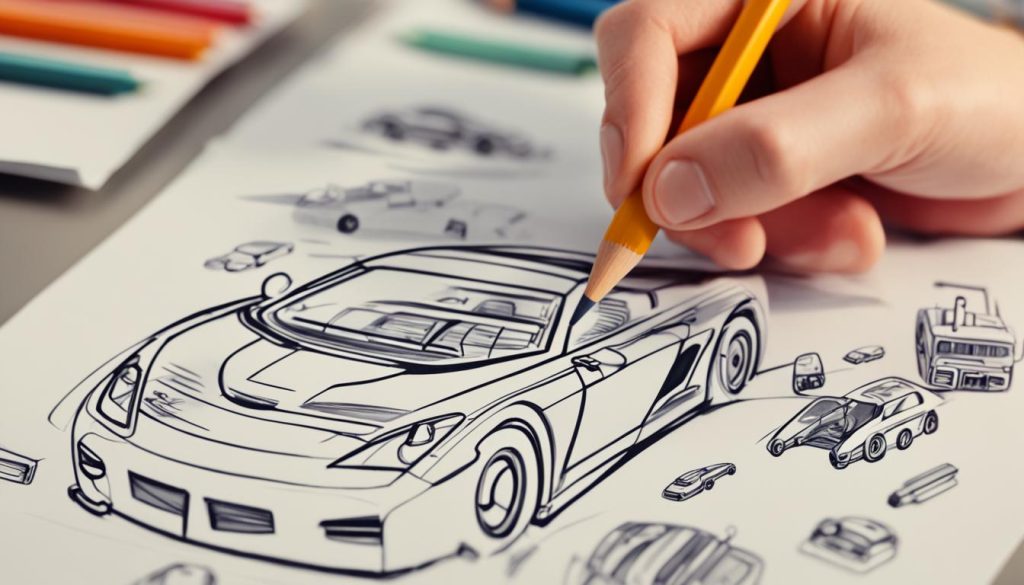
Ultimately, car drawing as a learning tool for kids has the power to ignite their passion for both art and design. So, let them explore their imaginations, practice their drawing skills, and watch as they develop their own unique style through the exciting world of car design.
Customizing and Personalizing Car Drawings
In the world of car drawing, the possibilities are endless. While our previous sections have provided you with essential techniques and tutorials, it’s time to unleash your creativity and take your car drawings to the next level. In this section, we’ll explore the exciting realm of customizing and personalizing car drawings.
One of the ways to make your car drawings stand out is to add unique elements that reflect your imagination. By incorporating different vehicles, extravagant features, or even imaginary elements like dinosaurs, you can infuse your drawings with a sense of individuality and intrigue.
Let your artistic flair run wild as you think outside the box and experiment with unconventional ideas. Whether you want a futuristic flying car or a vintage ride with a modern twist, there are no limits to what you can create on paper.
As you customize your car drawings, consider how these additional elements can enhance the overall composition and narrative. Are you aiming for a sleek and aerodynamic design or a rugged and off-road look? The choices are yours to make.
Mix and match different design elements, explore various styles, and play with unconventional color schemes to create captivating effects. Remember, the goal is to make your drawings truly unique and reflective of your artistic vision.
To help spark your imagination, here are some car sketching ideas to consider:
- Combine elements of different car models to create a hybrid or futuristic concept.
- Experiment with exaggerated proportions, such as oversized wheels or elongated bodies.
- Add personalized details, such as intricate patterns, decals, or custom paint jobs.
- Integrate elements from nature, such as vines or flowers, to create a harmonious blend.
By customizing and personalizing your car drawings, you’ll not only showcase your artistic skills but also create pieces that truly speak to your unique style and perspective. Let your creativity soar and watch as your drawings become one-of-a-kind masterpieces.

Showcasing and Sharing Car Drawings
Sharing your car drawings with others is a fantastic way to showcase your talent and connect with fellow artists. It’s a chance to inspire and be inspired, and to receive valuable feedback and support. Here are a few reasons why showcasing and sharing your car drawings is so important:
Bond with a Community of Artists
By sharing your car drawings online, whether it’s through social media or art platforms, you have the opportunity to connect with like-minded artists from around the world. Joining online art groups or participating in drawing challenges can help create a sense of community. You can learn from each other, exchange tips and tricks, and build lasting friendships with fellow car enthusiasts.
Inspire and Motivate Others
“Every artist was first an amateur.” – Ralph Waldo Emerson
Your car drawings can serve as inspiration for aspiring artists and beginners. You never know who might see your work and find the motivation to start drawing cars themselves. By sharing your artwork, you can ignite a spark of creativity in others and help them discover their own artistic potential.
Receive Valuable Feedback
Sharing your car drawings allows you to receive feedback from other artists and car enthusiasts. This feedback can be incredibly valuable in improving your skills and techniques. Constructive criticism and suggestions for improvement can help you refine your style and take your car drawings to the next level. Embrace feedback as an opportunity for growth and learning.
Build Confidence and Pride
When you share your car drawings and receive positive feedback, it boosts your confidence and validates your artistic abilities. It’s a reminder of your progress and the hard work you’ve put into honing your car drawing skills. Being proud of your artwork and sharing it with others is an essential part of your artistic journey.

Sharing your car drawings not only brings joy and fulfillment to you as an artist but also allows you to connect with a wider audience. It’s a way to inspire others, learn from fellow artists, and further your growth as an artist. So, don’t hesitate to showcase your car drawings and let your creativity shine!
Conclusion
In conclusion, this article provides a comprehensive guide on how to draw a car, offering valuable insights into various techniques and approaches. Whether you are a beginner looking for step-by-step tutorials or an experienced artist seeking inspiration, this guide has you covered. The article explores realistic drawing techniques, enabling you to create detailed and accurate car illustrations. It also delves into conceptual design approaches, allowing you to unleash your creativity and explore unique car sketching ideas.
For those interested in a more playful and lighthearted style, the article presents a tutorial on drawing cartoon cars. Additionally, it provides tips for adding color and details, enhancing your car drawings with vibrant hues and unique features. Moreover, the guide highlights the importance of customization and personalization, encouraging artists to think outside the box and create their own signature car designs.
Throughout the article, various car drawing techniques and illustration tips are shared, enabling artists to hone their skills and develop their own style. Whether you prefer realistic renderings or imaginative and conceptual designs, this guide empowers you to explore different art forms and techniques. And remember, don’t be afraid to share your car drawings with others. Sharing your artwork can foster a sense of community and inspiration among fellow artists, providing valuable feedback and encouragement on your artistic journey.
